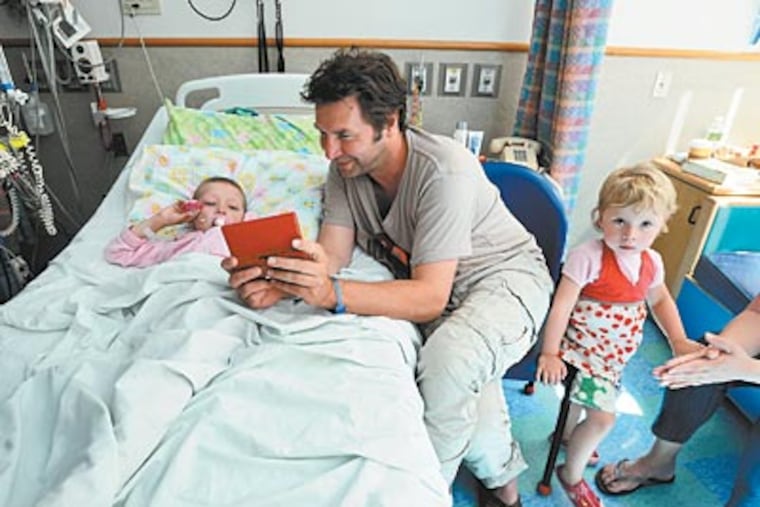Center's goal: Turning research into life-saving action
As Dutch native Lise De Boer, 5, lies in a bed at Children's Hospital of Philadelphia, undergoing the second of five rounds of care to destroy the remaining cancer in her little body, cancer doctor Stephan Grupp toils across the street in a new $504 million building to develop the next generation of treatment for patients like her.

As Dutch native Lise De Boer, 5, lies in a bed at Children's Hospital of Philadelphia, undergoing the second of five rounds of care to destroy the remaining cancer in her little body, cancer doctor Stephan Grupp toils across the street in a new $504 million building to develop the next generation of treatment for patients like her.
De Boer, her parents, and her 3-year-old sister traveled to Children's from the Netherlands, drawn by the kind of work now occurring in the Ruth and Tristram Colket Jr. Translational Research Building, the newest addition to the hospital's growing West Philadelphia campus.
The goal of researchers in this 12-story building, which is being dedicated Wednesday, is to speed the process of converting scientific discoveries into actual treatments, said Philip R. Johnson, Children's chief scientific officer.
The building assembles state-of-the-art equipment with researchers in such areas as cancer, diabetes, epilepsy, blindness, and hemophilia.
The Children's effort is not unusual. On the eastern end of the lot where Colket now stands, the University of Pennsylvania built its Perelman Center for Advanced Medicine, which also assembles clinicians and researchers to encourage faster development of treatments.
Children's Hospital Boston - a rival for national honors - has a similar program but houses its researchers in two older buildings.
Fox Chase Cancer Center and Thomas Jefferson University are among the local institutions engaged in this kind of research.
In recent years, the National Institutes of Health has pushed researchers to do a better job of converting the tens of billions of dollars a year the government spends on medical research into new treatments. The Colket building is one response.
In the short term, success would be gauged in the traditional currency of academic medicine - research grants from NIH and published articles. Some discoveries could take decades to achieve, Johnson said.
The building was launched by a $25 million grant from Tristram Colket, a Campbell Soup Co. heir and a Children's board member, and his family. The rest of the money came from a $100 million bond issue and existing funds at Children's, which has been profitable in recent years. The hospital earned $57.5 million on $1.3 billion in operating revenues in fiscal 2009.
By one measure - recruiting top talent - the building is already paying off, Johnson said.
In July, Douglas C. Wallace, a leading researcher in mitochondrial diseases who has nearly $2 million in NIH funding, will move his research group to the Colket building.
Wallace was recruited from the University of California, Irvine. Johnson also expects Wallace to employ eight top scientists to lead various parts of his team.
Similarly, Katherine A. High, a leading hemophilia and blindness researcher, will move her Center for Cellular and Molecular Therapeutics into the new building.
The Center for Childhood Cancer Research, led by John M. Maris, expects to add five people. That's on top of three people recruited in the last year "who are completely focused on doing the clinical trials in the children after discoveries are made in the laboratories," Maris said.
In all, Johnson said, the Colket building will have 500 people involved in research activities.
Grupp, director of translational research for the cancer research center, was involved in the initial trials that led to the treatment that Lise De Boer is getting. Her regimen uses engineered proteins - monoclonal antibodies and cytokines - to boost her immune system and destroy cancer cells.
The treatment has shown success, but is grueling and painful for children.
Now Grupp is working to genetically engineer the patient's own immune cells - T cells - to wipe out the cancer cells more effectively.
"I think this will be easier and less toxic to the children, but what I am really looking for is to make it work better," Grupp said.
A small trial is now under way using Grupp's T cell approach on leukemia patients at Children's and on adults at the Hospital of the University of Pennsylvania who face a high risk of recurrence. If the results are positive, Grupp anticipates a national trial.
For Grupp, the Colket building has been a boon. His team moved in last October. He said that the core infrastructure made it possible for him to use resources and equipment that would otherwise be out of reach for an individual researcher.
For example, he uses a $100,000 Xenogen camera that can capture images of cells tagged with luciferase - the enzyme that lights up fireflies' tails - and actually shows how well his engineered T cells are attacking the neuroblastoma cells.
In a sad twist, Grupp, 50, who has pioneered stem cell transplants, was diagnosed with a form of non-Hodgkin's lymphoma, a blood cancer, in late 2008. After chemotherapy, he is now undergoing weekly immunotherapy.
If that fails, he noted, "patients with my diagnosis are eligible for the adult clinical trial using the T cell" immunotherapy that he developed for leukemia.
Happily, for most adults like Grupp and most children with leukemia, that next stage isn't necessary.
"We are happy to take care of those patients, and we do very well for them," Grupp said of children with easily treated leukemia and other cancers, "but what we work on are the problems that aren't solved."